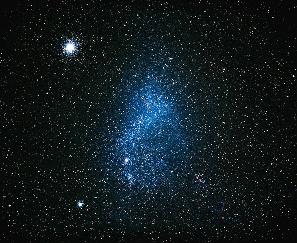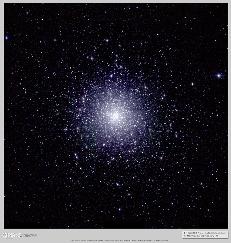Tucana
SMC - The Small Magellanic Cloud: Irregular Galaxy
47 Tucanae - Globular Cluster
This small constellation, close to the south celestial pole, is best seen in springtime. Though small, with few bright stars, it contains two of the jewels of the southern sky.
SMC - The Small Magellanic Cloud Irregular Galaxy E B L
This is a small companion galaxy to our own Milky Way. It lies at a distance of 210 to 250 thousand light years, making it the third nearest galaxy to us (after the Large Magellanic Cloud and a dwarf elliptical galaxy in Sagittarius). It covers an angular extent of 280 by 160 arc minutes appearing as a faint cloud against a dark sky. The SMC must have been known since antiquity but it was 'discovered' by the explorer Ferdinand Magellan in 1519. To the unaided eye it appears like a little piece of the milky way. Binoculars and telescopes will show that it contains both open star clusters and bright nebulae. The SMC contains a large number of hot blue stars. As these have a relatively short life it shows that the SMC has recently undergone a period of star formation. The SMC follows a nearly circular orbit around our galaxy. Knowing the period and diameter of the orbit enables a calculation to be made of the total mass of the Milky Way galaxy. This turns out to be substantially more than the calculated mass of normal matter (in the form of stars, planets, gas and dust) and thus indicates the presence of 'dark matter' - a form of matter about which little is yet known.
Position: 00h 52.7m -72deg 50min
C106 - 47 Tucanae Globula Cluster E B M
Close to the SMC lies the second largest and brightest globular cluster in the sky. With a visual brightness of very close to 4, it is easily seen with the unaided eye under dark skies - its stars covering an area about the size of the full moon. It ranks second to Omega Centauri but it is only 0.05 magnitudes fainter - a virtually insignificant difference. Both 47 Tucanae and Omega Centauri exceed the brightness of any other globular clusters circling our galaxy by a factor of three. It was not 'discovered' until 1751 when it was observed by Lacaille, but had been charted as a 'star' in Bayer's 1603 Uranometria. (It was Bayer who gave the brighter stars their Greek letter designations.) 47 Tuc (its common abbreviation) lies just over 13,000 light years from the Sun - one of the closest globular cluster to us. Its brightest stars are about 14th magnitude so they can be resolved with an 8inch (200mm) telescope as individual points of light against the diffuse background glow from fainter stars in the cluster. It has a well defined compact core. Globular clusters are composed of some of the oldest stars in our galaxy - some estimates give them an age of over 12 billion years! This helps put constraints on our models of the evolution of the Universe. It MUST be older that the oldest stars!
Position: 00h 24.1 -72deg 05min





